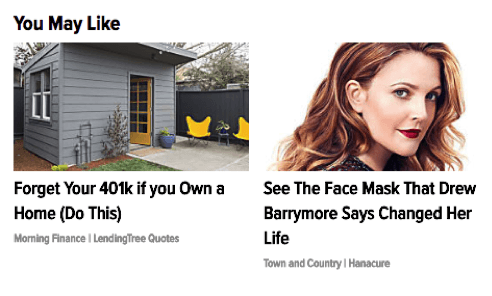In an ever-evolving eCommerce world, one thing’s for certain— brands that capture the attention of their core consumers come out on top. Newly defined advertising strategies pop up all the time — that’s what sets digital marketing apart from the old world of traditional marketing — and some work better than others.
Today, we’re taking a deep dive into the world of native ads, a kind of advertisement that’s gaining steam for one primary reason. Despite offering significant selling potential, it doesn’t look like an advertisement at all!
What Are Native Ads?
The official definition of native advertising is “a form of paid media where the ad experience follows the natural form and function of the user experience in which it is placed.” In other words, it’s an advertisement that looks and acts as if it’s native to its surroundings.
You’ve probably scrolled through Instagram, Facebook or Twitter before and noticed a post that looks like all the other messages, but it includes small text that reads “sponsored” or “promoted.” These, as well as Google’s paid search result listings, are considered native ads.
Of course, this kind of advertising stands in stark contrast to “old” advertising methods, like traditional banner ads and pop-up ads. The primary difference is that typical digital ads are physically set apart from the on-page content that viewers find valuable, while native ads are integrated into the content that users consume. What’s more, native ads are often more relevant to the user and incorporate copy and images that pertain to the rest of the content on the page.
The Six Kinds of Native Ads
There are many different ways to make an ad look native to its environment. You can alter the format and design of the ad so that it appears aesthetically similar to what’s around it or by adjusting the ad’s copy, so it ties into the page’s content. The Interactive Advertising Bureau (IAB) segments native ads into six distinct categories, all of which function in one of these two ways:
In-Feed Units
Sometimes referred to as “in-stream native advertising,” in-feed units are ads placed within the feed of a website, like Facebook or Twitter. They may be stories, videos, app installs ads or product listing ads.
Example: The Instagram ad below for Flaviar, a whiskey subscription service, is designed to look like a photo posted by an individual Instagram user — it doesn’t divert much from the look of a regular post — but it’s actually a “sponsored” in-feed native ad.
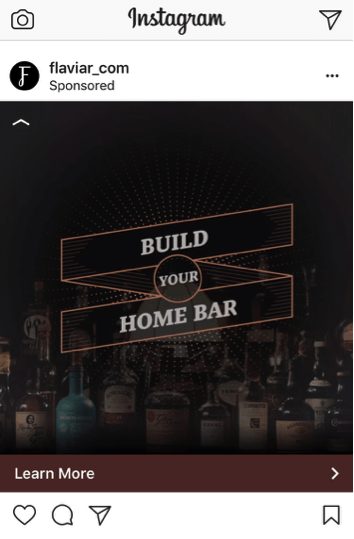
Paid Search Units
These kinds of native ads appear at the top of the search engine results page (SERP) when a user queries a search engine. They look and behave like organic search rankings, but they are marked as ads.
Example: The Springbot ad below looks like an organic search listing, but it was published through AdWords. You can tell that search results are advertisements when they have the green “ad” image next to the URL.
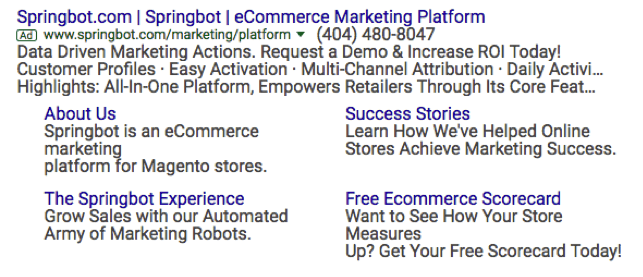
Recommendation Widgets
Often considered the most profitable native ads, recommendation widgets use customer data to suggest similar content. They are usually placed directly onto editorial web pages — separate from the content — to entice a user to click through to other pages.
Example: The example below, taken from the Huffington Post, appears in a news story on both desktop and mobile. Advertisers may gather consumer data or use ad retargeting to remind users of a product or service they explored before, presenting it as a recommendation.
Promoted Listings
Promoted listings can be seen on shopping websites, like eBay, Etsy or Amazon. They look and behave just like standard listings, but are promoted by a specific brand. They are generally labeled as an advertisement.
Example: On Etsy, native ads often look the same as regular search results, with the only differentiator being the white “ad” icon at the top left. Advertisers may target consumers who have searched for similar products or bought from their store in the past.
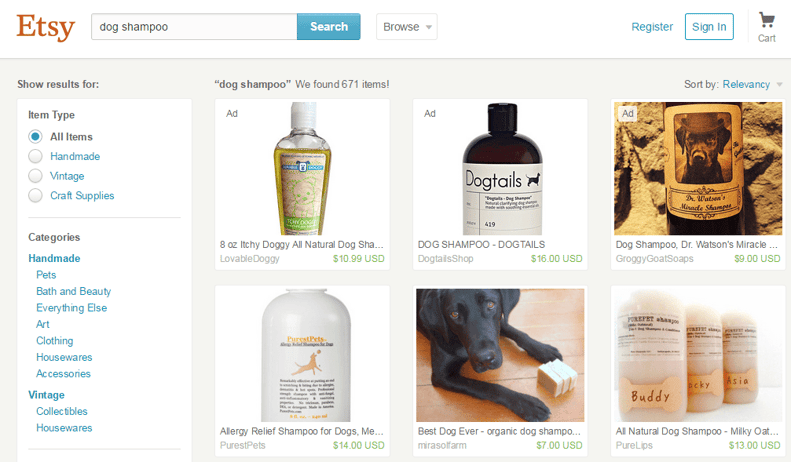
In-Ad with Native Element Units
These kinds of native ads look the most like typical web ads. You may see one on the side or top of a webpage. The thing that makes this kind of ad “native” is that it references something relevant to the content on the page.
Example: The Aldi ad below was placed on the page of an article with the headline “The Best Summer Appetizers.” In every way, it looks like a regular on-page ad. The only thing that makes it native is that its message is relevant to the content on the page.
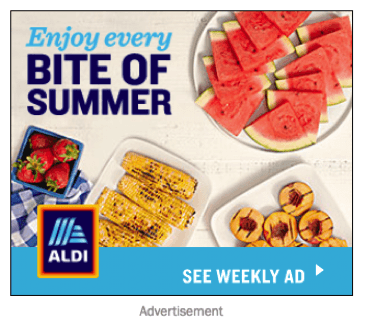
Custom
Lastly, the IAB includes custom native ads in its lineup to account for the ads that don’t fit neatly into one of the other five categories. Custom varieties are often developed exclusively between a publisher and an advertiser.
Example: One of our favorite custom native ads is the integration of Starbucks advertising on the popular game, Pokémon GO. A few months after the game launched, the app turned all Starbucks locations into PokéStops, with integrated advertising that looks similar to the stops that aren’t sponsored. If you’re not familiar with the game, PokéStops are physical locations where players can go to earn items that help them advance.
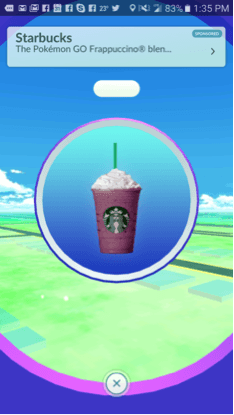
The Benefits of Native Ads
Now that we know what native ads are and how they function, let’s look at why they’re particularly relevant in today’s digital marketing world. Most importantly, do they work? The research suggests some compelling evidence. According to AdRoll’s native ad survey, these kinds of ads get 52 percent more views and bring an 18 percent boost in purchase intent compared with banner ads. Here are more benefits of native ads:
- They Get More Time — According to Sharethrough, readers equally spend as much time viewing native ads as they do editorial content. That means that you have more time to make an impression and encourage a conversion than you would with a typical banner ad. It also means that users are more likely to check out your native ads over your typical ads.
- They’re More Effective — The same Sharethrough report showed that consumers view these kinds of ads as they would editorials, which means that they’re less likely to view them as “salesy,” which could lead to more conversions. They may even interpret them as user-generated content, which can help boost your company’s reputation.
- They Get More Engagement — Not only are users more likely to view native ads, they’re also more likely to engage with the brands that post them. In fact, native ads garner 53 percent more engagements than other kinds of ads. If your goal is action-oriented rather than awareness-oriented — like you want to attract more followers or subscribers — native ads are the way to go.
- They’re More Relevant to Consumers — These days, it isn’t enough to design a one-size-fits-all advertisement for all customers. You have to leverage your demographics and data to build ads designed specifically for your customer base. Native ads help you reach the right customers in the places where they’re most comfortable.
Why They Work
But why, exactly, do these kinds of ads work? Simply put, it’s because they don’t look like ads. The biggest challenge for today’s marketer is to figure out how to develop advertisements that users aren’t inclined to tune out. The brain becomes conditioned to weed out information that isn’t useful, and consumers become accustomed to ignoring traditional ads. Native ads appear like the content consumers value, so they’re less likely to fuzz them out.
There’s also a scientific angle to consider. Sharethrough and Nielson teamed up to study how users process mobile ads and discovered that native ads receive two times more visual focus than banner ads. In other words, they capture consumers’ attention more effectively and therefore get more engagement and view time. Rather than appearing in a user’s peripheral field of vision, native ads are placed front and center, surrounded by information that’s considered relevant to the consumer.
How to Use Them to Your Advantage
With all this in mind, it’s clear that you should be spending some time developing native advertisements to sell your brand. Here are a few great tips for getting started on leveraging native ads to bolster your eCommerce traffic.
- Use Language that Fits — The goal of native advertising is to fit seamlessly on the page. Make sure that you’re speaking naturally, focusing on a voice that suits the platform and your core demographics. Make your ad copy driven by authenticity so it will speak to your target audience in their own language.
- Know Your Demographics — The cardinal rule of digital marketing is to know your demographics, but this is especially important in native advertising. Develop a target audience using our eCommerce analytics software, and then spend some time researching your core consumer. Of course, you need to know where your user likes to spend time online, so you can funnel your advertising dollars into native ads placed on the platforms where they’ll get the most attention.
- Think About the Subconscious — The study mentioned above by Nielson and Sharethrough found that native ad headlines could be optimized to trigger specific word associations, which may subconsciously influence a consumer’s brand perception. Choosing words that foster positive emotions can help users develop a more positive view of your company or encourage them to take action.
- Make it Interesting —When designing your next native ad campaign, think about your mental state while you’re browsing the web — you know that you’ll quickly scroll past posts that are uninteresting or irrelevant to you. The key to an excellent native campaign is to make it capture the user’s attention without being too abrasive or disruptive to the surrounding environment.
- Optimize Headlines — This one is especially important for brands that want to market to millennials since one in five users in that age group reads the headline exclusively. Think of the headline of your native ad as the content itself — if it’s not relevant, punchy and engaging, your campaign is likely to be a flop. AdRoll emphasizes the importance of making your ad copy credible, trustworthy and timely.
- Diversify Your Portfolio — Before you launch any native ad campaigns, you should do a little research to know where you’re most likely to reach the most valuable customers; what works for one brand on Instagram may not work for another. However, you should still spend some time experimenting with different platforms and exchanges to see which ones work the best for your business.
Is it Worth the Hype?
There is substantial evidence to suggest that this type of advertising is significantly more powerful than the old-school banner ads of the past. Native ads work — and are therefore definitely worth the hype — because they play to the consumer’s subconscious. Users have evolved to consume and digest more information than ever, and they are adept enough to be able to weed out information that’s not pertinent.
So finding solutions that keep content fresh, relevant and engaging is more important than ever. Native advertising is definitely worth the time and investment, at least until we evolve to tune it out, too.


